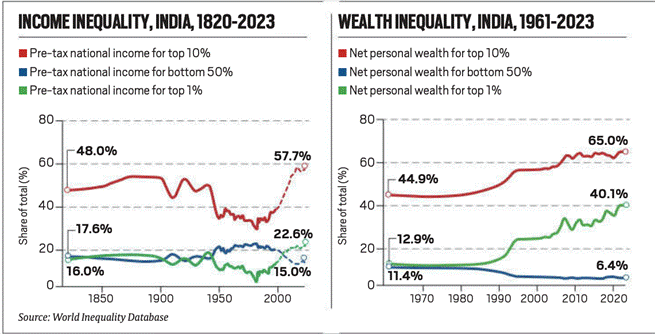Inequality and the Gini Debate
- In July 2025, the Government of India cited a World Bank brief ranking India as the 4th most equal country globally, based on the consumption-based Gini index (Gini: 0.29).
- However, this ranking masks the ground reality, as income and wealth inequalities in India are among the highest globally, as per the World Inequality Database.
- As of 2023:
- Top 1% earned 22.6% of national income and held 40.1% of total wealth.
- Bottom 50% earned 14.6% of income and held only 6.4% of wealth.
- The Gini index based on consumption does not capture asset inequality, capital income, or structural disadvantages — leading to misleading claims of equality.
- This raises critical questions about the validity of India’s equality claims, the limitations of survey-based data, and the need for multidimensional inequality metrics.
Relevance : GS 3(Indian Economy ,Inequality , Gini Co-efficient)

Claim vs Reality: Gini Index Interpretation
- World Bank’s Brief (2024) ranked India as the 4th most equal country based on consumption-based Gini index.
- India’s Gini index (consumption) was estimated at 0.29, implying low inequality.
- Issue: This metric ignores income and wealth inequality, which are significantly higher.
Income Inequality is Rising Sharply
- As of 2023:
- Top 1% income share: 22.6%
- Top 10% income share: 57.7%
- Bottom 50% share: just 14.6%
- Reflects a threefold gap between top 1% and bottom 50% in income control.
- Source: World Inequality Database
Wealth Inequality is Even More Stark
- In 2023:
- Top 1% own 40.1% of total personal wealth.
- Top 10%: 65%
- Bottom 50%: only 6.4%
- Indicates extreme concentration of wealth.
- Historical trend: Wealth inequality has been consistently rising since the 1990s.
Limitations of Consumption-Based Gini
- It underestimates inequality because:
- Consumption is smoother across households (poor borrow; rich save).
- Surveys underreport elite consumption.
- Rural-urban price differences and housing costs are not well-adjusted.
- Gini fails to capture wealth hoarding, capital gains, inheritance effects.
Survey Quality Issues Distort Findings
- NSSO and NSO surveys suffer from:
- Non-response bias
- Under-sampling of top-income households
- Outdated consumption baskets
- This results in misleading aggregate equality metrics.
India’s Claim Omits Income/Wealth Data
- World Bank brief did not include income or wealth Gini (India does not officially publish them).
- Other global rankings using income or wealth inequality place India far lower in equality metrics.
Taxation System Does Not Correct Inequality
- Pre- and post-tax income share of top 10% shows little difference.
- Indicates that India’s taxation is not redistributive enough.
- Direct taxes and wealth taxes are limited; subsidies don’t offset wealth concentration.
Bigger Picture Missed: Structural Inequality
- Gini does not account for:Caste-based or gender inequalityEducational or health access gapsIntergenerational mobility blockages
- These structural issues exacerbate long-term inequality, especially among marginalised communities.
Global Comparisons are Misleading
- Nordic countries (e.g., Denmark) rank equal on both consumption and income metrics.
- India’s claim of equality collapses when judged on income, asset ownership, or human capital indicators.
- Suggests cherry-picking one metric to portray a broad narrative.
Policy Implications
- Need for triangulation: Combine consumption, income, and wealth data to assess inequality holistically.
- Revise tax structures to be more progressive.
- Improve data transparency: India must release periodic income and wealth Gini estimates.
- Strengthen social safety nets, asset redistribution schemes, and education/health access to reduce long-term disparities.



